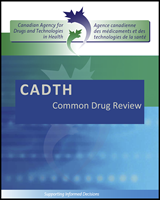Except where otherwise noted, this work is distributed under the terms of a Creative Commons Attribution-NonCommercial-NoDerivatives 4.0 International licence (CC BY-NC-ND), a copy of which is available at http://creativecommons.org/licenses/by-nc-nd/4.0/
NCBI Bookshelf. A service of the National Library of Medicine, National Institutes of Health.
Omalizumab (Xolair): Treatment of Adults and Adolescents (12 Years of Age and above) with Chronic Idiopathic Urticaria [Internet]. Ottawa (ON): Canadian Agency for Drugs and Technologies in Health; 2015 Aug.

Omalizumab (Xolair): Treatment of Adults and Adolescents (12 Years of Age and above) with Chronic Idiopathic Urticaria [Internet].
Show detailsThis section was summarized by CADTH staff based on the input provided by patient groups.
1. Brief Description of Patient Group(s) Supplying Input
The Canadian Skin Patient Alliance is a non-profit, patient-centred organization that serves patients with dermatological conditions in Canada by providing education, support, and advocacy. It also acts as an umbrella organization for more than 20 affiliated skin disease–specific organizations across Canada. The Canadian Skin Patient Alliance has received unrestricted grants from Novartis, AbbVie, Amgen, Celgene, GlaxoSmithKline, Leo Pharma Inc., Janssen, Merck, Roche, and Valeant. It declares no conflict of interest in the preparation of its submission.
2. Condition and Current Therapy-Related Information
Information was gathered via paper questionnaires distributed by two dermatologists to their patients with chronic idiopathic urticaria (CIU) and online questionnaires distributed via Facebook to CIU patients who had experience with omalizumab. Twenty-five questionnaire responses were received, and two patients who gave permission were contacted by phone for an interview.
CIU or chronic spontaneous urticaria is characterized by the spontaneous occurrence of itchy hives, often accompanied by angioedema, and can last up to six weeks per attack.
Patients reported that attacks are unpredictable, causing a significant amount of anxiety (88%), affecting sleep (96%), and impacting what foods they can eat (72%) and what jobs they can obtain (50%). In addition, the majority of patients reported a decrease in self-confidence (92%) and constantly feeling the need to hide the affected skin (96%). A patient described the impact of CIU in this way: “I’ve had severe swelling of the lips, leading to feeling uncomfortable in public situations and affecting my self-esteem. Because instances of CIU have been unpredictable, I have also been anxious in not knowing if I will have a flare during an important life event.”
Patients also reported that their disease had a negative impact on family members and caregivers: “They have to put up with my anxiety and depression. Plus now that I have damage to my back due to prednisone use, I need help doing household chores and cannot participate in some sports.” Due to the debilitating effects of attacks on patients and the side effects of current therapies, caregivers often need to help the patient with self-care, grooming, washing, and other basic functions.
Survey respondents reported using over-the-counter antihistamines, doxepin, hydroxychloroquine, and prednisone. Concerns with current treatment include treatment effectiveness and intolerable side effects. Patients expressed a need for a treatment that effectively deals with the urticaria, itch, and angioedema while having tolerable side effects. At this moment, an effective therapy with tolerable side effects is lacking.
3. Related Information About the Drug Being Reviewed
All respondents except one had experience with omalizumab as part of a clinical trial. All patients expressed that omalizumab managed their symptoms better than previous treatments with a great reduction or complete eradication. Omalizumab was the only medication that could treat the skin eruptions and swelling. Although the subcutaneous administration of omalizumab by a specialist may be more complicated than self-administered pills, patients were willing to undergo the time and effort of monthly specialist visits for the benefits experienced with omalizumab. Side effects of omalizumab included headaches and fatigue after receiving the injection, but patients noted that these would disappear: “Minor headache, joint pain, and tired for a few days after monthly injection. So worth it.” Five patients were able to reduce their intake of prednisone or antihistamines after receiving omalizumab. Patients feel that omalizumab could be a “life-changer.”
4. Additional Information
Given that CIU affects the patient’s ability to work, patients with this condition may be less likely to have access to private insurance.
- PATIENT INPUT SUMMARY - Omalizumab (Xolair)PATIENT INPUT SUMMARY - Omalizumab (Xolair)
- REVIEW OF OTHER HTA AGENCY REPORTS - Ingenol Mebutate (Picato)REVIEW OF OTHER HTA AGENCY REPORTS - Ingenol Mebutate (Picato)
- DISCUSSION - Edoxaban (Lixiana)DISCUSSION - Edoxaban (Lixiana)
- Ingenol Mebutate (Picato)Ingenol Mebutate (Picato)
- DinitrochlorobenzeneDinitrochlorobenzeneA skin irritant that may cause dermatitis of both primary and allergic types. Contact sensitization with DNCB has been used as a measure of cellular immunity. DNCB is also use...<br/>Year introduced: 1987(1975)MeSH
Your browsing activity is empty.
Activity recording is turned off.
See more...